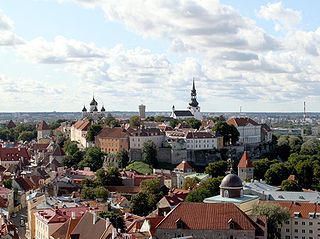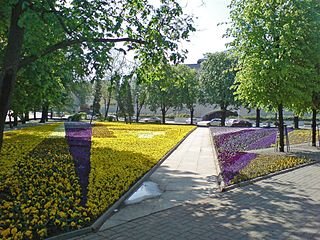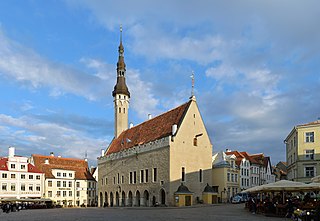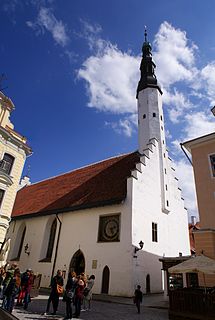
Tallinn is the capital, the most populous and the primate city of Estonia. Located in the northern part of the country, on the shore of the Gulf of Finland of the Baltic Sea, it has a population of 437,619 in 2020. Administratively a part of Harju County, Tallinn is the main financial, industrial and cultural centre of Estonia; the second largest city, Tartu, is located in the southern part of Estonia, 187 kilometres (116 mi) southeast of Tallinn. Tallinn is located 80 kilometres (50 mi) south of Helsinki, Finland, 320 kilometres (200 mi) west of Saint Petersburg, Russia, 300 kilometres (190 mi) north of Riga, Latvia, and 380 kilometres (240 mi) east of Stockholm, Sweden. From the 13th century until the first half of the 20th century Tallinn was known in most of the world by its historical German name Reval.

Toompea is a limestone hill in the central part of the city of Tallinn, the capital of Estonia. The hill is an oblong tableland, which measures about 400 by 250 metres, has an area of 7 hectares and is about 20–30 metres higher than the surrounding areas. In folklore the hill is known as the tumulus mound over the grave of Kalev, erected in his memory by his grieving wife.

St. Mary's Cathedral, Tallinn is a cathedral church located on Toompea Hill in Tallinn, Estonia. Originally established by Danes in the 13th century, it is the oldest church in Tallinn and mainland Estonia. It is also the only building in Toompea which survived a 17th-century fire.

The Catholic Church in Estonia is the national branch of the worldwide Catholic Church, under the spiritual leadership of the Pope in Rome.

The history of Jews in Estonia starts with reports of the presence of individual Jews in what is now Estonia from as early as the 14th century.

The Kopli cemetery was Estonia's largest Lutheran Baltic German cemetery, located in the suburb of Kopli in Tallinn. It contained thousands of graves of prominent citizens of Tallinn and stood from 1774 to shortly after World War II, when it was completely flattened and destroyed by the Soviet occupation authorities governing the country at the time. The former cemetery is now a public park.

Tõnismägi is a 36-metre high hillock adjacent to Toompea hill in Tallinn, Estonia.

The Estonian Orthodox Church of the Moscow Patriarchate is a semi-autonomous church in the canonical jurisdiction of the Patriarchate of Moscow whose primate is appointed by the Holy Synod of the latter.

The Estonian History Museum is a museum about the history of Estonia in Tallinn. It was initially established by chemist Dr. Johann Burchart who ran the town hall pharmacy known as the Raeapteek.

St. Nicholas Church is a medieval former church in Tallinn, Estonia. It was dedicated to Saint Nicholas, the patron of the fishermen and sailors. Originally built in the 13th century, it was partially destroyed in the Soviet bombing of Tallinn in World War II. It has since been restored and today houses the Niguliste Museum, a branch of the Art Museum of Estonia, focusing mainly on ecclesiastical art from the Middle Ages onward. The former church is also used as a concert hall.
This article covers the architecture of Estonia.

Tallinn Christmas Market is a Christmas market held every year in Tallinn, Estonia. The modern Christmas market was founded in 1997 and it is open from the last week of November to the first week of January the following year. Founded by Paul Oberschneider, the market brings tourists from all over the world to Tallinn. This is due to the Julian calendar according to which, the Christmas Day of the Russian Orthodox Church is on 7 January.

The Tallinn Town Hall is a building in the Tallinn Old Town, Estonia, next to the Town Hall Square. It is the oldest town hall in the whole of the Baltic region and Scandinavia.

The Brotherhood of Blackheads is an association of local unmarried merchants, ship owners, and foreigners that was active in Livonia from the mid-14th century till 1940 but still remains active in present-day Hamburg. The Brotherhood of Blackheads was founded as a military organization but the non-military aspects of the association gradually became more pronounced until the Brotherhood became a predominantly social organization after the end of the Great Northern War.
Armenians in the Baltic states of Estonia, Latvia, and Lithuania settled there mostly during the Soviet occupation of the Baltic States.

The Church of the Holy Ghost or Church of the Holy Spirit is a medieval Lutheran church in the old town district of Tallinn, Estonia. It is located behind Raekoja plats, and lies opposite the Great Guild and Maiasmokk, Tallinn's oldest café.

The Great Guild was a guild for merchants and artisans, operating in Tallinn from at least the 14th century until 1920. It was based in the Great Guild hall, a Gothic building in the historical centre of Tallinn, today housing the Estonian History Museum.

House of the Blackheads, or House of the Brotherhood of Black Heads, in Tallinn, the capital of Estonia, is a former headquarters of the Brotherhood of Blackheads. Historically this was a professional association of ship owners, merchants and foreigners dating from the 14th century. They were active in Livonia but fled to Germany during the Soviet occupation of the Baltic States in 1940. The House of the Blackheads was visited by several Russian Emperors including Peter I, Paul I and Alexander I who also became honorable members the Brotherhood.

Schlössle Hotel is a hotel in Tallinn, Estonia. Now a five-star establishment, its history goes back to the 14th century when there were warehouses on the site. The two houses forming today's structure were built in the mid-18th century.

St. Olav's Guild was a guild in Tallinn, Estonia. The guild was named after Olaf II of Norway.


















